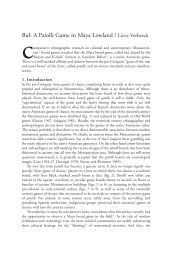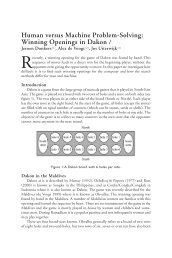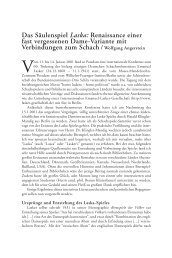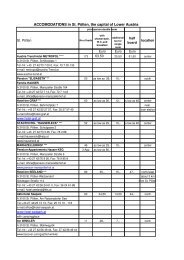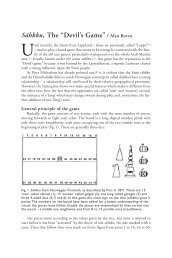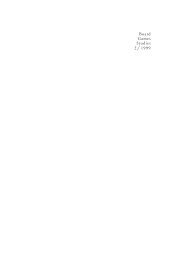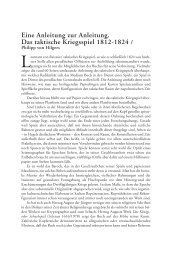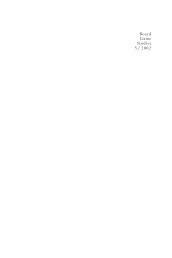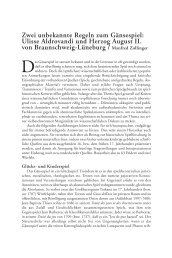“Juden Raus!” (Jews Out!) – History's most - Board Game Studies
“Juden Raus!” (Jews Out!) – History's most - Board Game Studies
“Juden Raus!” (Jews Out!) – History's most - Board Game Studies
Create successful ePaper yourself
Turn your PDF publications into a flip-book with our unique Google optimized e-Paper software.
52<br />
B OARD G AME S TUDIES 6, 2003<br />
is either on his way either to the central square, or coming back from it, to land on several<br />
marked squares, and consequently to collect several hats to bring to the collection<br />
point. When he has handed in six hats, he must go back to the central square. If he is<br />
the first to do this, he wins First Prize.<br />
Published by Günther and Co., D.<strong>”</strong><br />
Possible Origins and Reconstruction<br />
“<strong>Jews</strong> <strong>Out</strong>!<strong>”</strong> is a modified race game with two versions of the rules given. The first<br />
version is a simple game of chance with no interaction between the players. The second<br />
version adds a little more strategy to the game and is similar in feeling to “Parchisi<strong>”</strong> or<br />
“The Hyena <strong>Game</strong><strong>”</strong> (Bell 1979). The main source for the game was certainly “Fang den<br />
Hut<strong>”</strong> (English title “Trap the Cap<strong>”</strong>), a game published by Otto Maier Verlag,<br />
Ravensburg, as early as 1927 and still distributed today in various countries (Glonnegger<br />
1999: 23-24). Two different versions of “Fang den Hut<strong>”</strong> exist, one version is for six players.<br />
The game board uses a graphic of a wagon wheel, with pieces able to move along<br />
squares on the diameter of the circle and also on the spokes running straight from the<br />
outer edge of the circle to the center (figure 5). It was obviously this board that was<br />
adopted by the author of <strong>“Juden</strong> <strong>Raus</strong>!<strong>”</strong>. But the game board lay out, inspired by the<br />
modern design of the Bauhaus, underwent some changes: <strong>“Juden</strong> <strong>Raus</strong>!<strong>”</strong> depicts a<br />
medieval town with an irregular city wall and streets instead of the outer circle and the<br />
straight spokes seen in “Fang den Hut<strong>”</strong>. The black fields of “Fang den Hut<strong>”</strong> where the<br />
caps were captured became Jewish storefronts. A further difference to “Fang den Hut<strong>”</strong>,<br />
where the counters can move around the circle and along the spokes, pieces in <strong>“Juden</strong><br />
Fig. 5. “Fang den Hut<strong>”</strong> (photograph U. Schädler, Swiss Museum of <strong>Game</strong>s).



